CDC Releases ‘Preparing for the Health Effects of Drought: a Resource Guide for Public Health Officials’
 The Centers for Disease Control and Prevention (CDC) Releases ‘Preparing for the Health Effects of Drought: a Resource Guide for Public Health Officials’
The Centers for Disease Control and Prevention (CDC) Releases ‘Preparing for the Health Effects of Drought: a Resource Guide for Public Health Officials’
Although the public health effects of drought can be severe, they are often hard to observe or measure directly, making them easy to overlook. Of the lengthy list of such effects, some of the most prominent are:
- reduced access to potable water, food sources compromised
- increases in vector-borne diseases and infections due to changes in the patterns and populations of disease carriers
- increased respiratory distress, including increased risk of respiratory infections
- increased risk of dehydration as well as heat exhaustion and heat stroke during heat waves
- worsening of chronic illnesses
- adverse mental health effects including stress, anxiety, and depression
- For more information, click here for the CDC’s brochure on Drought and Public Health in the U.S.
The prevalence of drought-related health effects varies widely, depending on drought severity, local population vulnerability, existing public health infrastructure, and available resources to mitigate effects as they occur. As a result, public health preparedness efforts may differ significantly between different communities.
In 2010, the Centers for Disease Control and Prevention (CDC) published When Every Drop Counts: Protecting Public Health During Drought Conditions—A Guide for Public Health Professionals. This guide advocated for the inclusion of public health into drought preparedness and response plans, highlighting the many potential adverse effects of drought on human health.
Recently, the CDC National Center for Environmental Health released a supplement guide called Preparing for the Health Effects of Drought: A Resource Guide for Public Health Professionals. This new guide contains five modules, providing best practices on conducting vulnerability assessments, collaboration among stakeholders, communicating drought preparedness and response strategies, and where to find (and how to use) data on drought. The guide also includes a list of valuable resources for public health professionals. The authors of the guide also developed two attractive, user-friendly handouts that can be easily customized and reproduced for community outreach.
A panel of subject matter experts, including NIDIS key partners, provided in-depth and first-hand knowledge to enhance the information in the guide. NIDIS will continue to collaborate with CDC and key partners on providing the best available information and tools needed to assess, prepare for, and mitigate the public health impacts of drought
Are you working at the interface of drought and public health? Please consider submitting an abstract to one of our upcoming conference sessions “Understanding Linkages Between Drought and Public Health: Can We Improve Drought Early Warning?”. Click to submit to the American Geophysical Union Fall Meeting and American Meteorological Society Annual Meeting by August 1.




